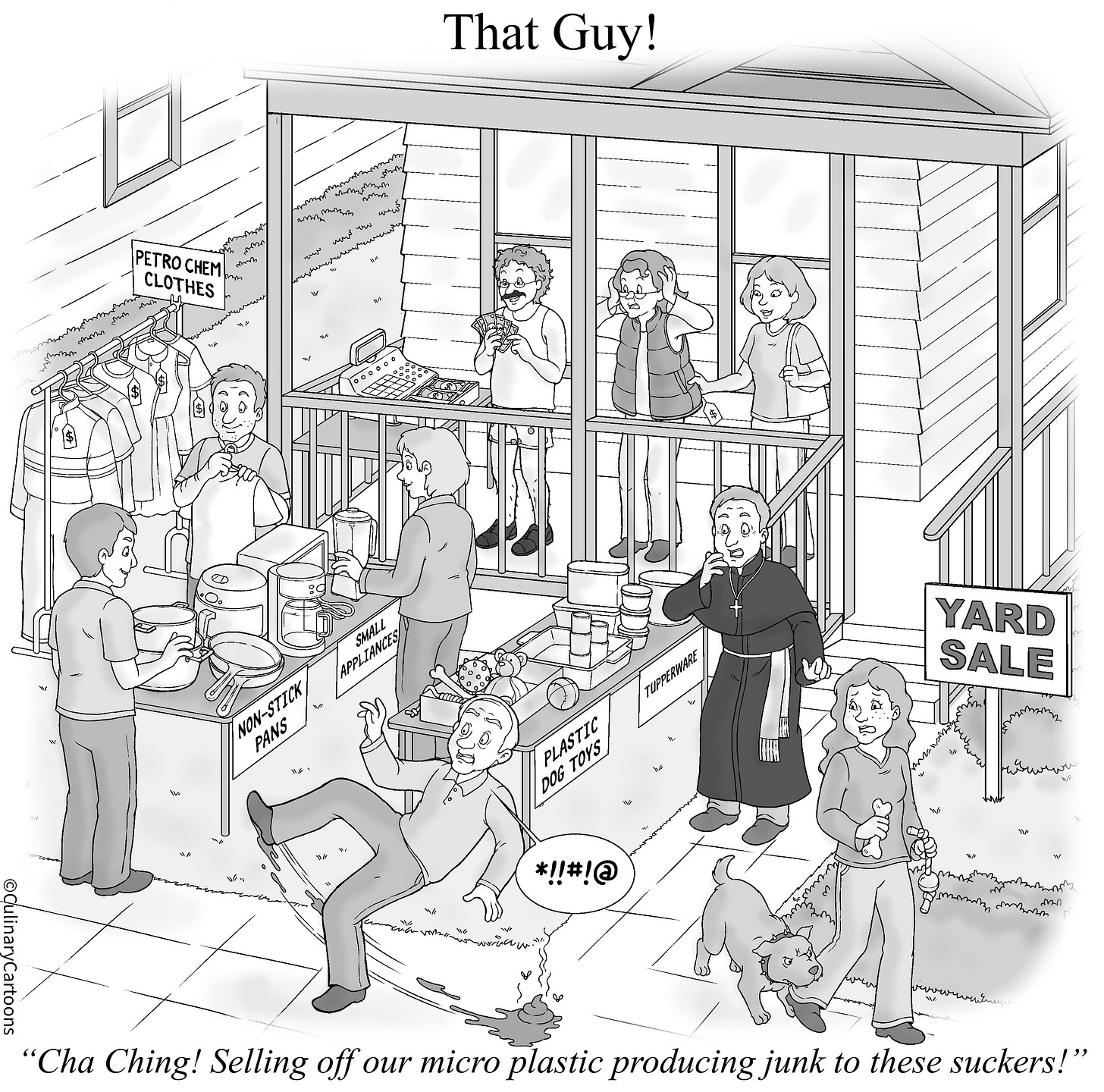Toxic Textiles
You Are What You Wear.
Funnies and Foodies November 2025
By Jan Walsh
Giggle: Sucker Sale
That Guy is cashing out of his polyester pants, with plans to purchase a new wardrobe made of natural and organic fabrics. But he does not stop there! He is also tossing everything else toxic that he can get his hands “off” and selling to unsuspecting sheeple. As usual Dearie had no clue this was coming and is about to lose the shirt off her back! And Hooligan can’t let go of his plastic toys and anyone who buys them. So he is giving it his all, from teeth to tail to stop them.
Gab: Chemical Clothing
In the 1980s I purchased flame retardant pajamas for my babies. My God. What was I thinking? They were not firemen. I was exposing them to the dangers of flame-retardant (FR) clothing. The risks range from skin irritation from chemicals, such as formaldehyde. And when FR materials do burn, they can release toxic gases. This was likely my first purchase of chemical clothing. Today toxic textiles are everywhere!
Natural fibers have been used in the textile industry for more than 5,000 years. Synthetic fibers became more widely used in the last 30 years, currently totaling 60% of textile production. Synthetic clothing releases VOCs (volatile organic compounds), which are a large group of carbon-based chemicals that easily evaporate into the air at room temperature. And synthetic fabrics release microfibers during everyday wear and laundering. Microplastics include three main groups: spheres, fragments, and microfibers. And microfibers, small fibers released from textiles and fibrous materials, are the most problematic. These microfibers are often derived from plastics, such as polyester and nylon, The microfibers can become airborne and inhaled, potentially causing inflammation, oxidative stress, and migration to other tissues. And when your skin is in contact with polyester it absorbs endocrine disrupting chemicals (EDCs), microplastic and toxic chemicals. Some sports bras have 22 times the safe limit of BPA, a chemical compound that is used to make plastics. Microplastics are now found in breast milk.
Connect the dots! Skin is porous, absorbing toxins from clothing as well as feminine products. While searching for a cure for cancer, perhaps we might avoid what is obviously causing it. A study published in October 2025 Environmental Research is the first to attempt at mass screening harmful chemicals in clothing. The research found hundreds of different chemicals in the clothing, including pesticides, flame retardants, and pharmaceuticals.
Goods: Not A Thing To Wear!
Over the past year I have lost three dress sizes, the natural way. No drugs or diets. Just eating more protein and animal fats. Yet my new weight has an unintended consequence of having nothing to wear. Just as I purged my pantry and started over, I am tossing clothes from my closet and shopping for new. But rather than reading food labels this time I am reading clothing labels for where, what, and how.
Where was it made?
I prefer organic, natural textiles, made in the USA, Europe, or Australia. While it is not difficult to find the country of origin on labels if shopping in stores, when shopping online it might say, “Imported” instead. This leaves me to ask AI where various brands are made. It is not always clear. Companies sometimes import the fabric from one country and make it in another. I do not find many organic offerings especially in petites. Eileen Fisher is an exception.
What is it made of?
I am shopping for cotton, linen, leather, silk, wool, and cashmere. It is difficult to find these fabrics, especially in 100 percents. Yet plastic and petrochemical clothes are everywhere! The market is flooded with acrylic, nylon, spandex, elastane, polyester, and (Yikes!) recycled polyester…
How was it made?
I don’t want polyester at all, much less recycled polyester! Recycled polyester (rPET) fibers are often shorter and more fragile than regular polyester, increasing the shedding of microplastics, which are also released into water during laundering, contaminating oceans and the food chain. Harmful chemicals, such as antimony (a catalyst), formaldehyde (a preservative), and phthalates (a plasticizer) can be used during the manufacturing process of recycling polyester. Phthalates and BPA can act as endocrine disruptors, while antimony is toxic. Some studies suggest that recycled polyester may contain higher levels of certain toxic chemicals compared to regular polyester due to the high-temperature recycling process and potential contamination during recycling.
My eyes glaze over reading about this stuff, and writing about it… I long for the days when shopping was fun! I could try it on and if it fit, I was out the door. But they won’t stop making it until we wake up to what we are wearing and stop buying it.


